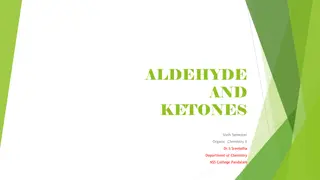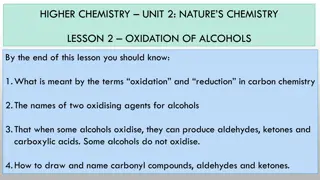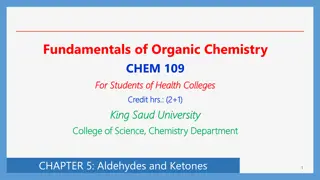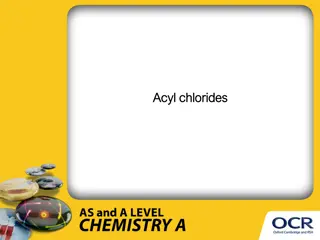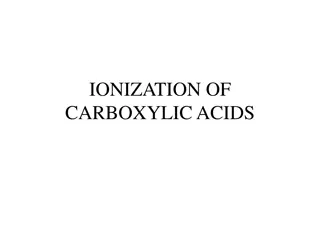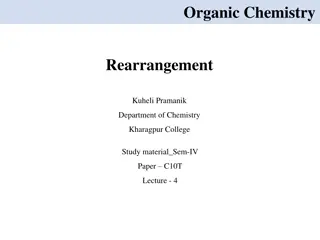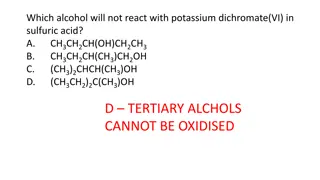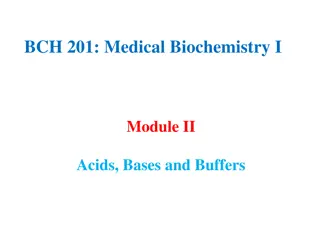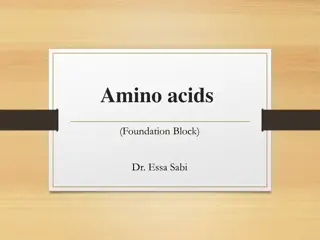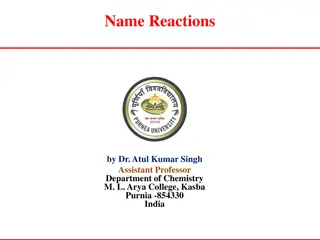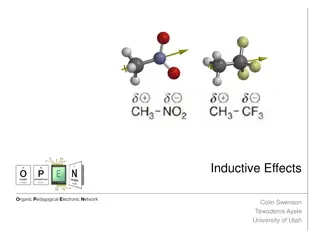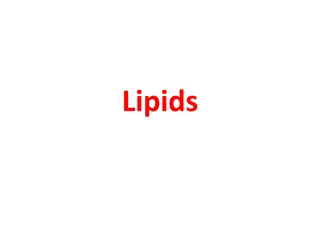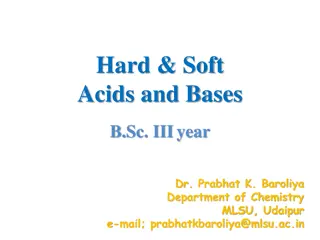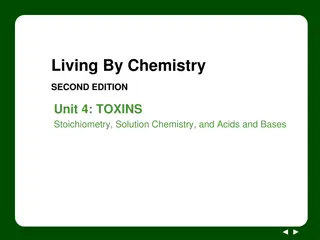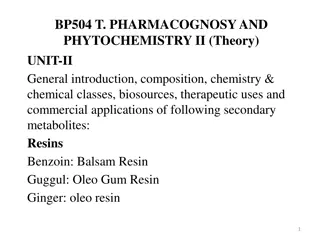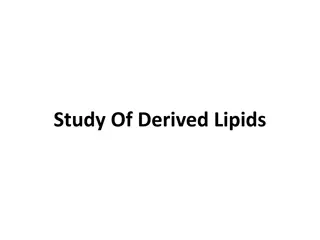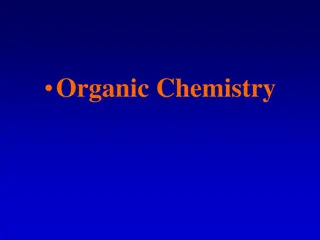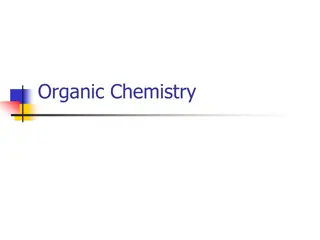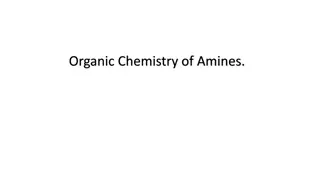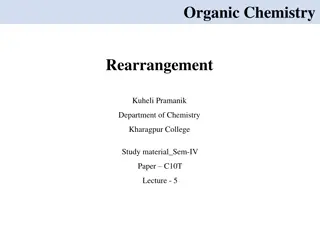Understanding Aldehydes, Ketones, and Carboxylic Acids in Organic Chemistry
Functional groups like aldehyde, ketone, and carboxylic acids play a crucial role in organic compounds, influencing reactivity and properties. Carbonyl compounds containing carbon-oxygen double bonds exhibit unique characteristics. Ketone bodies have biological significance, especially in conditions like diabetes. Monitoring and managing ketone levels are essential for overall health.
Download Presentation

Please find below an Image/Link to download the presentation.
The content on the website is provided AS IS for your information and personal use only. It may not be sold, licensed, or shared on other websites without obtaining consent from the author. Download presentation by click this link. If you encounter any issues during the download, it is possible that the publisher has removed the file from their server.
E N D
Presentation Transcript
LECTURE NO.3 ALDEHYDE, KETONE, AND CARBOXYLIC ACIDS Functional group In most organic compounds, atom or group of atoms arrange within a molecule to give a compound new chemical, and physical properties. Mostly the functional group is the non- hydrocarbon part, sometimes are atoms often (contain O, N, S, or P) in an organic compound. Hydrocarbon Chemical Formula Functional group of Hydrocarbon Alcohol ( R- CH2 OH ) Hydroxyl group (-OH ) Aldehyde RCHO Carbonyl group ( -C H =O ) Alkene ( R2 C = C R2 ) Double Bond (> C = C <) Carboxylic acid RCOOH Carboxyl group(-COOH), & Hydroxyl(-OH). Ketone R CO Carbonyl group (>C=O ) Figure 1: The functional groups of Alcohol, Aldehyde, Alkene, carboxylic acid, and Ketone. Carbonyl group (>C=O) is a functional group of (Aldehyde, Ketone), Double Bond (> C = C <), and in carboxylic acid both carbonyl group and hydroxyl group (-OH) are the functional groups functional group Functional Groups Reactivity Functional groups play a significant role in increasing its reactivity, by controlling the direction of the reactions; Alkyl chains (R C - C R ) are nonreactive, but when substituted ( R C = C R ) give unsaturated alkyl chains, the presence of functional group (> C = C <) allow for relative increase in both reactivity and specificity. Carbonyl Compounds Carbonyl Compounds are consist of carbon- oxygen double bounded (>C=O). Its polar or water soluble due to ability to form Hydrogen bonding, respectively as in, figure(2) bellow. Aldehyde, Ketone, and carboxylic acids are all containing of carbonyl group, so they called Carbonyl Compounds. Figure(2): carbonyl group, and hydrogen bonding.
Aldehyde, Ketone, and carboxylic acids Biological Significance of Ketone Bodies: Aldehydes, and ketones are critical in human body , they present as carbohydrates, fats, proteins, nucleic acids, hormones, vitamins, other organic compound, and Drugs. Acetone is the most important ketone to your health, and present in less than 1 mg/100 mL of blood. An excess of acetone in the bloodstream is a common symptom of diabetes. Insulin is a hormone that allows glucose from the bloodstream to enter cells. Diabetic is a persons with deficient in insulin, either lacking insulin or are resistant to insulin. Because there is no insulin in the body, a diabetic is forced to break down fatty acids and proteins for energy, which produces a large quantity of ketone bodies. This can be prevented by monitoring insulin levels within the body. However, if a diabetic's body is subjected to stress, such as an illness, disruption to insulin treatment, or surgery, a condition called diabetic ketoacidosis (DKA) can occur. When a diabetic's body is in a stressful situation, it produces hormones such as adrenaline, which increase the rate of converting fatty acids to energy. This causes ketone bodies to accumulate. When so much acetone builds up in the blood, the body attempts to eliminate it all by causing excessive urination. Symptoms of diabetic ketoacidosis include dehydration, deficiencies in salts such as potassium, nausea, fatigue, confusion, abdominal cramping, excessive thirst, and decreased perspiration. DKA can be treated through undergoing insulin therapy, replenishing the body with the fluids and electrolytes, and diminishing stress. The most common way to test for an excess of ketones in the bloodstream is a urine test, also blood test will be more accurate. Although it is dependable way of determining ketone buildup, ketone breathe excess is often associated with fruity smelling breath.[Reference: https://chem.libretexts.org/ and 5.3 Functions and Applications of Aldehydes and Ketones Difficulty Level: Basic | Created by: CK-12]
(a) (b) Figure (3): a- Plasma concentration of Glucose, and Ketone Bodies at starvation. b--The Acetone-Urine test is a simple urine test to detect the level of acetones in the body. When the acetones in the blood go above a certain level. Reference http://gooddayshealthcare.in/product/acetone-urine/ The presence of Aldehyde, Ketone, and carboxylic acids: Aldehyde, Ketone, and carboxylic acids arepresent in different compounds of human body, here is some of them:- -Monosaccharide's: Monosaccharide's are carbohydrates which can not be hydrolyzed to small molecules, contain carbons with functional aldehyde, or keto group are present in nature. Aldohexose is glucose, Fructose is ketohexose respectively. Glucose is present in our blood, and gives rise to energy on oxidation. - Aldopentose Ribose is constituent of nucleic acids monomer of DNA. -Ketone Bodies: Ketone Bodies are : acetoacetate, beta-hydroxy butyrate, &acetone. Ketone Bodies are water soluble fuels normally exported by the liver but overproduced during fasting or diabetes mellitus. Ketone Bodies are formed in the hepatic mitochondria to be used as fuel for human activities. CARBOXYLIC ACIDS: A class of organic compounds consist of a carbonyl group( >C=O ), attached to a hydroxyl group ( -OH ) to generate a carboxyl group( -COOH ),it s a weak acid. Acetic acid meaning Vinegar, the other example in human body is fatty acid. Using the definition of an acid as a "substance which donates protons (hydrogen ions) to other things", the carboxylic acids are acidic because of the hydrogen in the -COOH group. In solution of water, a hydrogen ion is transferred from the ( -COOH ) group to a water molecule, you get an acetate ion formed together with a hydroxonium ion, H3O+. CH COOH + H O CH COO + H3O+.
The pH of carboxylic acid solutions What makes a carboxylic acid more acidic? Acidity of carboxylic acid is higher than alcohols. Carboxylate ion, the conjugate base of carboxylic acid is stabilized by two equivalent resonance structures in which the negative charge is effectively delocalized between two more electronegative oxygen atoms. Fig.4. Fig.4: Carboxylic acid resonance structures showing increasing acidity, where R = CH .The Normal Arterial pH in Human Body is (7.35-7.45). At low pH the Arterial pH cause. Metabolic Acidosis, which refer to increase acid generation. Fig.4: Carboxylic acid resonance structures showing increasing acidity, where R = CH . Metabolic Acidosis cause: 1-Ketoacidosis, when you have diabetes and don't get enough insulin, and get dehydrated, your body burns fat instead of carbohydrates as fuel, and that makes ketones accumulation in your blood, so turn it acidic. 2-Alcoholism, People who drink a lot of alcohol for a long time and don't eat enough also build up ketones. 3- Renal tubular acidosis. Healthy Kidneys Kidney take acids out of your blood and get rid of them in your pee. Kidney diseases as well as some immune system and genetic disorders can damage kidney so they leave too much acid in your blood. 4- Ingestion Salicylates. The clinical Features:The clinical Features evolved rapidly over 24 hours and early signs: Cause nausea, vomiting, and abdominal pain. The Carboxylic Acid Derivatives: The group (RC=O) is called the acyl group, which is a part of the functional group of the carboxylic acid derivatives, these derivatives include, esters, and amides. Figure bellow. The Carboxylic Acid Derivatives Carboxylic Acid Derivatives Esters amides Examples in living systems acetyl coenzyme A Paracetamol, penicillin.


